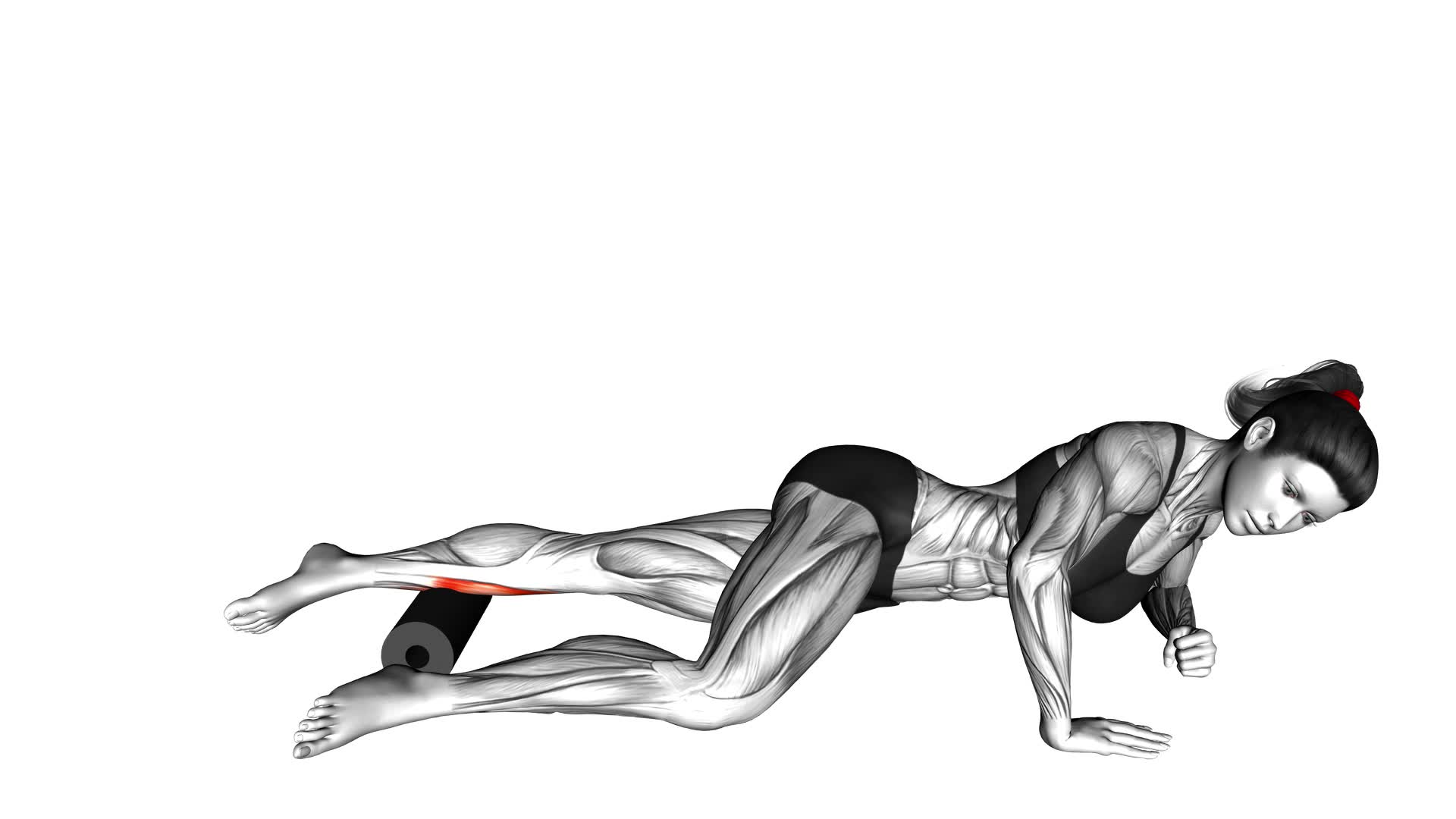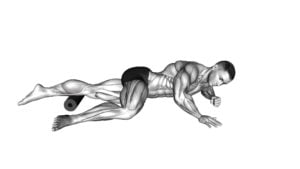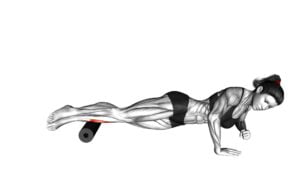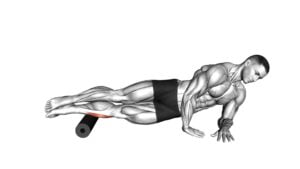Roll Peroneal (Single Leg) Side Lying on Floor (female) – Video Exercise Guide & Tips

In this video exercise guide, you'll learn how to perform the Roll Peroneal (Single Leg) Side Lying on Floor. This exercise, specifically designed for females, targets the peroneal muscles and helps improve balance and stability.
Watch This Exercise Video
With just a floor as your equipment, you'll be able to strengthen your legs and enhance your overall lower body strength.
Follow the proper form and technique to maximize the benefits of this exercise and avoid common mistakes.
Get ready to roll and feel the burn!
Key Takeaways
- The Roll Peroneal exercise targets the peroneal muscles and helps to strengthen the lower leg muscles.
- It improves balance and stability, as well as enhances ankle stability.
- This exercise can alleviate foot and ankle pain and is beneficial for rehabilitation after ankle injuries.
- The use of proper form and technique, along with modifications and progressions, can help maximize the effectiveness of the exercise and prevent injury.
Benefits of the Roll Peroneal Exercise
The roll peroneal exercise offers numerous benefits for improving ankle stability and strengthening the peroneal muscles. By incorporating this exercise into your routine, you can experience enhanced balance and coordination.
The primary benefit of the roll peroneal exercise is its ability to target the peroneal muscles, which are responsible for ankle stability. These muscles run along the outside of the lower leg and play a crucial role in preventing ankle sprains and maintaining proper alignment. Strengthening the peroneal muscles can also help alleviate foot and ankle pain caused by overuse or injury.
Another benefit of the roll peroneal exercise is its versatility. There are several variations of this exercise that can be performed to target different aspects of ankle stability and muscle strength. For example, you can perform the exercise with a resistance band or on an unstable surface, such as a balance board or foam pad, to further challenge your balance and strengthen the supporting muscles. Additionally, the roll peroneal exercise can be modified to focus on specific areas, such as the lateral ankle or calf muscles, by adjusting the positioning of the foot and ankle during the exercise.
Equipment Needed for the Exercise
To perform the roll peroneal exercise, you'll need some equipment to enhance the challenge and effectiveness of the workout. While this exercise can be done without any equipment, there are certain tools that can aid in modifying the exercise and providing additional support.
One recommended piece of equipment is an exercise mat or a soft surface to lie on. This will provide cushioning and comfort, especially if you have sensitive knees or elbows.
Another helpful tool is a resistance band. By attaching the band to a stable object and wrapping it around your leg, you can add resistance to the movement, making it more challenging for your muscles.
Additionally, using a foam roller can be beneficial for this exercise. Placing the foam roller underneath your bottom leg will create an unstable surface, forcing your stabilizing muscles to work harder during the movement.
Proper Form and Technique
To maintain proper form and technique while performing the roll peroneal exercise, use an exercise mat or soft surface for comfort and support. This will help reduce the risk of common injuries associated with improper form. One common injury that can occur is straining the muscles in the lower leg or ankle. This can happen if you don't maintain control and stability throughout the movement. To prevent this, focus on engaging the muscles of the lower leg and ankle, and avoid any sudden or jerky movements.
To advance the exercise and challenge yourself further, you can increase the range of motion. Instead of just rolling onto the side of your foot, try rolling all the way onto the outside of your foot and then back onto the inside. This will engage the peroneal muscles even more and provide a greater challenge for your balance and stability.
Another way to advance the exercise is by adding resistance. You can do this by using a resistance band or ankle weights. Simply wrap the resistance band around your foot or attach the ankle weights, and then perform the roll peroneal exercise as usual. The added resistance will increase the difficulty and help you build strength in your lower leg and ankle muscles.
In the next section, we'll discuss modifications and progressions that can be made to the roll peroneal exercise to suit your individual needs and goals.
Modifications and Progressions
To modify and progress the roll peroneal exercise, you can incorporate variations that target different muscles in the lower leg and ankle. Here are some modifications and variations you can try to challenge yourself and continue improving:
- Resistance Band: Attach a resistance band around your feet or ankles to add resistance and increase the difficulty of the exercise. This will specifically target the muscles in your lower leg and ankle, helping you build strength and stability.
- Weighted Object: Hold a weighted object, such as a dumbbell or kettlebell, in your hand while performing the exercise. This will add an additional challenge and require more control and stability from your lower leg and ankle muscles.
- Elevated Surface: Place your bottom leg on an elevated surface, such as a step or bench, while performing the exercise. This will increase the range of motion and further challenge your lower leg and ankle muscles.
Remember to start with the basic version of the exercise and gradually progress to the more challenging variations as you become stronger and more comfortable. It's important to listen to your body and only push yourself within your limits to avoid injury.
Common Mistakes to Avoid
Avoid these common mistakes when performing the roll peroneal exercise to ensure proper form and maximize the benefits.
Injury prevention is a key aspect of any exercise routine, and the roll peroneal exercise is no exception. One common mistake to avoid is using excessive momentum to roll the body. This not only diminishes the effectiveness of the exercise but also increases the risk of injury. Instead, focus on controlled movements and engage the core muscles to maintain stability throughout the exercise.
Another mistake to watch out for is neglecting balance and stability. The roll peroneal exercise is designed to improve these aspects, so it's important to maintain proper alignment and control. Avoid leaning too far forward or backward, as this can throw off your balance and compromise the exercise's effectiveness.
Additionally, be mindful of your breathing during the exercise. Holding your breath can lead to unnecessary tension and hinder your performance. Remember to inhale during the initial position and exhale as you roll the body.
Tips for Getting the Most Out of the Exercise
To maximize the benefits of the roll peroneal exercise and ensure optimal results, focus on maintaining proper alignment and control throughout the movement. This won't only help in improving balance but also in strengthening the ankle muscles.
Here are three tips to help you get the most out of the exercise:
- Engage your core: Before starting the roll peroneal exercise, activate your core muscles by drawing your belly button in towards your spine. This will help stabilize your body and maintain proper alignment throughout the movement.
- Control the speed: While performing the roll peroneal exercise, it's important to control the speed of the movement. Avoid rushing through the exercise and instead, focus on moving slowly and with control. This will challenge your ankle muscles and improve their strength.
- Maintain proper foot position: Throughout the exercise, make sure to keep your foot in a neutral position. Avoid excessive pronation or supination of the foot, as this can place unnecessary stress on the ankle joint. By maintaining proper foot alignment, you can target the peroneal muscles effectively and improve their strength.
Frequently Asked Questions
How Many Repetitions and Sets Should I Do for the Roll Peroneal Exercise?
To determine the number of repetitions and sets for the roll peroneal exercise, it's important to consider your fitness level and goals. Generally, it's recommended to perform 2-3 sets of 10-15 repetitions on each leg.
This exercise targets the peroneal muscles, which help to stabilize the ankle and improve balance. To ensure proper form and technique, lie on your side with one leg extended and the other bent. Roll onto the outside of your foot, then return to the starting position.
Can I Perform the Roll Peroneal Exercise if I Have a Previous Ankle Injury?
If you have a previous ankle injury, it's important to manage and rehabilitate it properly before attempting the roll peroneal exercise.
Consult with a healthcare professional or physical therapist for guidance on ankle injury management and rehabilitation options. They can provide alternative exercises to strengthen the ankle muscles and prevent further injury.
Safety and proper healing should be a priority before engaging in any exercise routine.
Is It Necessary to Warm up Before Doing the Roll Peroneal Exercise?
Before performing the roll peroneal exercise, it's important to warm up your muscles. This will help increase blood flow and flexibility, reducing the risk of injury.
Proper form is crucial in this exercise to target the peroneal muscles effectively. Common mistakes to avoid include using momentum to roll instead of controlled movements, and not keeping the core engaged.
Remember to start with a warm-up and focus on maintaining proper form to get the most out of the roll peroneal exercise.
Can the Roll Peroneal Exercise Help Improve Balance and Stability?
The roll peroneal exercise can significantly improve balance and stability. It's especially effective for athletes looking to enhance their performance and prevent injuries.
In rehabilitation programs, this exercise plays a crucial role in strengthening the ankle and lower leg muscles, promoting stability and reducing the risk of future injuries. By targeting the peroneal muscles, it helps improve proprioception and overall control of movement.
Incorporating the roll peroneal exercise into your routine can greatly enhance your balance and stability.
Are There Any Variations of the Roll Peroneal Exercise That Target Different Muscles?
There are indeed different variations of the roll peroneal exercise that target different muscles.
These variations can help athletes improve their balance and stability in specific areas.
By altering the position of the leg or adding resistance, you can engage different muscles such as the glutes, hamstrings, or hip flexors.
This allows for a more targeted and comprehensive workout, enhancing overall athletic performance.
Incorporating these variations into your routine can lead to improved strength, coordination, and injury prevention.
Conclusion
In conclusion, the Roll Peroneal exercise is a beneficial exercise for strengthening the muscles of the lower leg. It can be easily performed on the floor, requiring no additional equipment.
By following proper form and technique, individuals can effectively target the peroneal muscles and improve balance and stability.
With modifications and progressions, individuals can challenge themselves and further enhance their lower leg strength.
Remember to avoid common mistakes and follow the provided tips to maximize the benefits of this exercise.

Author
Years ago, the spark of my life’s passion ignited in my mind the moment I stepped into the local gym for the first time. The inaugural bead of perspiration, the initial endeavor, the very first surge of endorphins, and a sense of pride that washed over me post-workout marked the beginning of my deep-seated interest in strength sports, fitness, and sports nutrition. This very curiosity blossomed rapidly into a profound fascination, propelling me to earn a Master’s degree in Physical Education from the Academy of Physical Education in Krakow, followed by a Sports Manager diploma from the Jagiellonian University. My journey of growth led me to gain more specialized qualifications, such as being a certified personal trainer with a focus on sports dietetics, a lifeguard, and an instructor for wellness and corrective gymnastics. Theoretical knowledge paired seamlessly with practical experience, reinforcing my belief that the transformation of individuals under my guidance was also a reflection of my personal growth. This belief holds true even today. Each day, I strive to push the boundaries and explore new realms. These realms gently elevate me to greater heights. The unique combination of passion for my field and the continuous quest for growth fuels my drive to break new ground.







